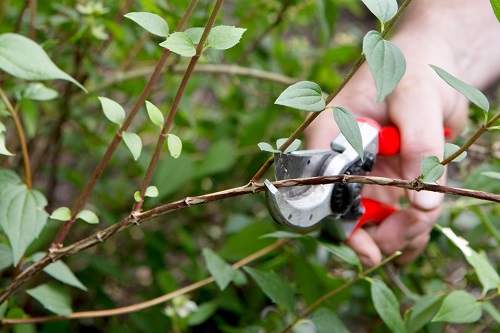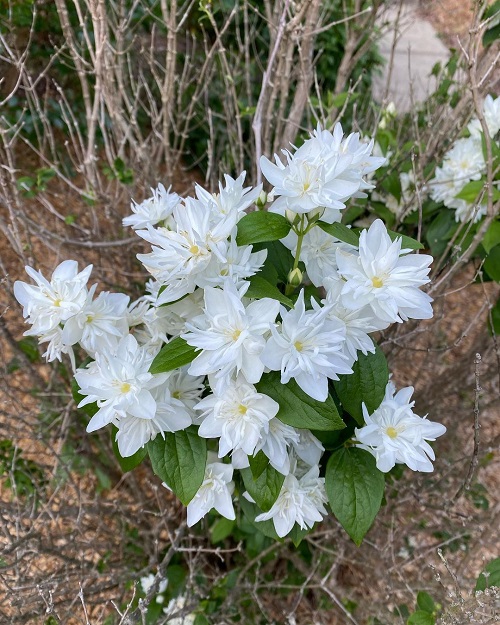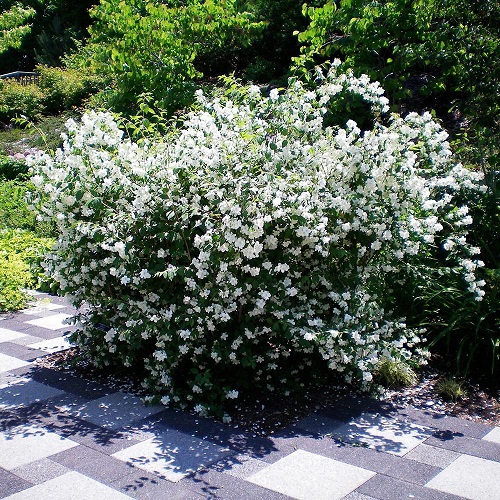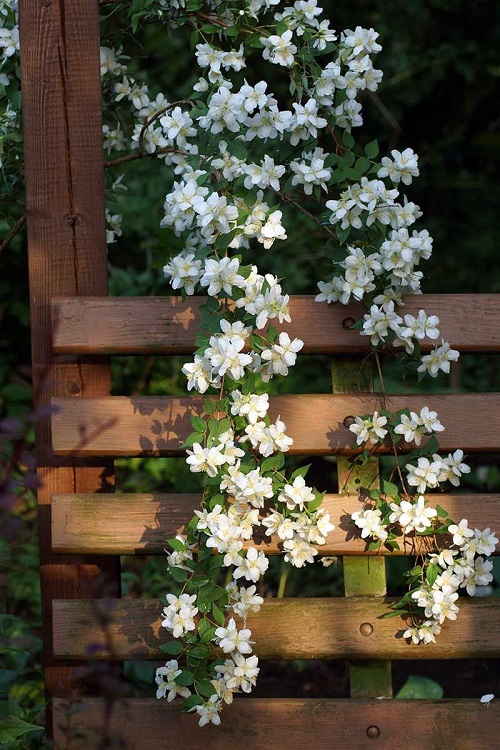Read about the growing requirements of Philadelphus Lewisii – a highly adaptable shrub that produces fragrant white flowers.
Philadelphus Lewisii, also known as Lewis’ Mock Orange, is a beautiful and fragrant shrub native to western North America. In this guide, we will discuss the care tips and requirements for growing this low-maintenance plant in your garden.
Common Names: Lewis’s Mock Orange, Lewis’ Mock Orange, Syringa, Wild Mock Orange, Indian Arrowwood, Gordon’s Mock Orange
Check out Pretty Ways to Grow Hydrangeas here
Philadelphus Lewisii Plant Information
Philadelphus Lewisii is a shrub with white, citrus-scented blooms that resemble orange flowers. It is named after either the Greek word for sibling love or a King Ptolemy Philadelphus from ancient times, though horticulturalists are not certain which one.
The highly adaptable Philadelphus Lewisii, can become a large shrub in the garden and reach up to 4-6 feet tall. It features oval green leaves that transform into yellow hues during the fall season. Its reddish-brown bark ages gradually into gray.
These plants that resemble orange blossoms thrive in various habitats, including sagebrush deserts, rocky slopes and hillsides, forest edges, moist open woodlands, and streamsides. It produces clusters of white flowers, usually in groups of three to fifteen, that have yellow centers and four petals.
Check out Different Types of Dogwood Tree Varieties here
Propagating Philadelphus Lewisii

Philadelphus Lewisii can be propagated through stem cutting or by layering.
Stem Cuttings:
- Take a stem cutting from a healthy, mature Philadelphus Lewisii plant. Choose a stem that is at least 4 inches long and has several leaves.
- Cut the stem cutting just below a node (the point on the stem where a leaf grows).
- Dip the cut end in the rooting hormone.
- Place the stem cutting in a pot filled with moist potting soil.
- Cover the pot with a plastic bag and place it in a warm, sunny location.
- Water the soil regularly to keep it moist.
- After several weeks, small roots will begin to form on the stem cutting.
- When the roots are 1-2 inches long, transplant the stem cutting into a larger pot.
Here are Outdoor Plants That Grow Without Sunlight
Layering:
- Choose a healthy, mature Philadelphus Lewisii plant.
- Find a low-hanging branch on the plant that is at least 4 inches long.
- Bend the branch down to the ground and hold it in place with a stake.
- Cover the branch with a few inches of potting soil.
- Water the soil to keep it moist.
- After several weeks, roots will begin to form on the branch.
- When the roots are 1-2 inches long, carefully cut the branch away from the parent plant.
- Transplant the branch into a pot with fresh potting soil.
Requirement for Growing Philadelphus Lewisii
Sunlight
Philadelphus Lewisii can grow well in both full sun and part shade. However, it tends to bloom more abundantly when exposed to direct sunlight for 5-6 hours daily.
It’s important to protect the plant from the intense afternoon sun by providing it with some partial shade.
Soil
Philadelphus Lewisii is tolerant of a variety of soil types, though it prefers moist, well-draining soil in full sun, with a pH range of 5.5-7.5.
Learn How to Check Your Soil pH at Home here
It does not tolerate wet or soggy soils and does best in a slightly acidic growing medium. If the soil is too alkaline, you can add sulfur or other acidic amendments to lower the pH.
Water
It is a hardy shrub that does not require a lot of water, but regular watering during the growing season will help to promote healthy growth.
During the summer months, water the shrub every week or two, depending on the weather conditions. During the winter months, water should be reduced to every couple of weeks. The soil should be kept moist but not soggy, so make sure not to overwater.
Here are Signs of Overwatering & How to Save an Overwatered Plant
Philadelphus Lewisii Care

Fertilizer
It is best to fertilize the shrub only once or twice a year, in spring and early summer, using a slow-release fertilizer with a balanced ratio of nitrogen, phosphorus, and potassium.
Avoid using a fertilizer with too much nitrogen, as this can cause the leaves to turn yellow and stunt the plant’s growth. Additionally, applying too much fertilizer can burn the roots and cause the shrub to die.
Here is a great Homemade Potassium Fertilizer Recipe
Pruning
To keep this plant healthy and prevent it from becoming too leggy, regular pruning is necessary. Follow the one-third rule when pruning. Each year, remove one-third of the oldest branches down to ground level. This will encourage new growth and help the plant look healthier.
In addition to pruning, make sure the plant is growing in moist soil conditions to promote healthy growth and flowering.
Pest and Diseases
Mock Orange is generally resistant to pests and diseases, but it may occasionally encounter aphids.
- If aphids are present, rinse them off the leaves, or use homemade insecticidal soap.
- Watering issues can also cause problems such as root rot from overwatering or stunted growth and poor blooming from underwatering.
- Monitor the soil moisture level regularly and water the plant when the soil is about 2 inches dry or when the leaves show signs of wilting or curling.
- Powdery mildew may also occur in unfavorable growing conditions. In this case, prune the affected branches and spray with sulfur or copper fungicides to prevent further spread.
Check out Effective Ways to Get Rid of Powdery Mildew here
Philadelphus Lewisii Plant Uses
The fragrant Mock Orange shrub is a magnificent asset to any garden, adding a unique aroma. With its arching tall branches and flower color, it serves as a perfect background for other plants, providing a sense of stature and structure to the garden.
In addition, the leaves and flowers of this plant contain high levels of saponins, which make them suitable for creating a lathering soap bar when mixed with water. While the plant is deer resistant, it attracts various pollinators, such as bees and hummingbirds, adding to its value in the garden.




